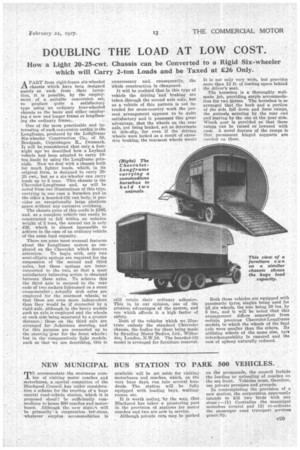DOUBLING THE LOAD AT LOW COST.
Page 51

If you've noticed an error in this article please click here to report it so we can fix it.
How a Light 20-25-cwt. Chassis can be Converted to a Rigid Six-wheeler which will Carry 2-ton Loads and be Taxed at E26 Only.
APART from rigid-frame six-wheeled chassis which have been designed purely as such from their inception, it is possible, by the employment of a suitable conversion set, to produce quite a satisfactory type using an ordinary four-wheeled chassis as the basis and either employing a new and longer frame or lengthening the ordinary frame.
One of the most practicable and interesting of such conversion outfits is the Longframe, produced by the Lotrgframe Six-wheeler Construction Co., of 58, Bredgade, Copenhagen K., Denmark. It will be remembered that only a fortnight ago we described how a Leyland vehicle had been adapted to carry 10to loads by using the Longframe principle. Now we deal with a chassis built for much lighter loads, which, in its original form, is designed to carry 2025 cwt., but as a six-wheeler can carry loads up to 2 tons. This chassis is the Chevrolet-Longframe and, as will he noted from our illustrations of this type, carrying in one case a horsebox and in the other a boarded-tilt van body, it provides an exceptionally large platform space without any excessive overhang.
The chassis price of this outfit is £286, and, as a complete vehicle can easily be constructed to fall within an unladen weight of 2 tons, the annual tax is only £26, which is almost impossible to achieve in the case of an ordinary vehicle of -the same load capacity.
There are some most unusual features about the Longframe system as employed on the Chevrolet which deserve attention. To begin with, only two semi-elliptic springs are required for the suspension of the second and third axles, but these springs are interconnected to the two, so that a most satisfactory balancing action is obtained between these axles. To achieve this the third axle is secured to the rear ends of two rockers fulerumed on a stout cross-member;. actually stub axles are employed for the rearmost wheels, so that these are even more independent than they would be if connected by a rigid.axle, although in the heavy models such an axle.is employed and the wheels at each side being separated by a greater distance ; those on the third axle are arranged for Ackerman steering, and for this purpose are connected up to the steering gear for the front wheels ; but in the comparatively light models. such as that we are describing, this is unnecessary and, consequently, the whole construction is cheapened.
It will be realized that in this type of vehicle the driving and braking are taken through the second axle only, but as a vehicle of this pattern is not intended for cross-country work the present arrangement appears to be quite satisfactory and it possesses this great advantage, that the wheels on the rear axle, not being braked, act as deterrents to side-slip, for even if the driving wheels were locked as a result of excessive braking, the rearmost wheels would
still retain their ordinary adhesion. This is, in our opinion one of the greatest advantages of the system, and one which affords it a high factor of safety.
Both of the vehicles which we illustrate embody the standard Chevrolet chassis, the bodies for these being made by Saurling Motor Bodies, Ltd., Willesden, Leticia/1, N.W.10. The boarded-tilt model is arranged for furniture removal. It is not only very wide, but provides more than 12 ft. of loading space behind the driver's seat.
The horsebox is a thoroughly wellmade job, providing ample accommodation for two horses. The horsebox is so arranged that the back and a portion of the side fall down and form ramps, the animals entering by the rear end and leaving by the one at the near side. Winch gear is provided so that these ramps can be raised or lowered with ease. A novel feature of the ramps is that permanent hinged supports are carried on them.
Both these vehicles are equipped with pneumatic tyres, singles being used for all six wheels, the size being 30 ins. by 5 ins., and it will be noted that this arrangement differs somewhat front certain previous Chevrolet-Longframe models, in which the wheels of the final axle were smaller than the others. By utilizing wheels of the same size, •tyre interchangeability is ensured and the cost of upkeep naturally reduced.












































































































